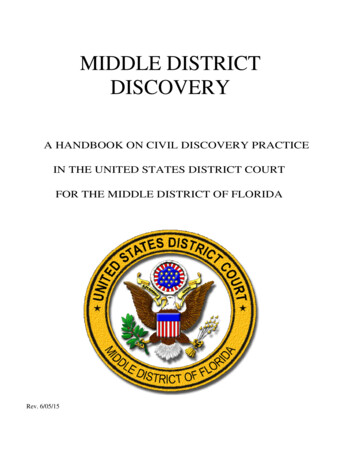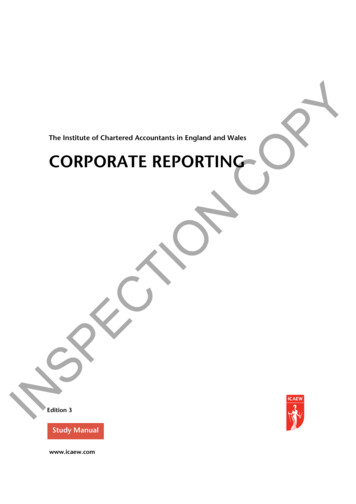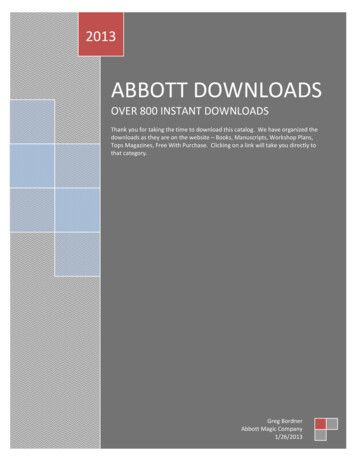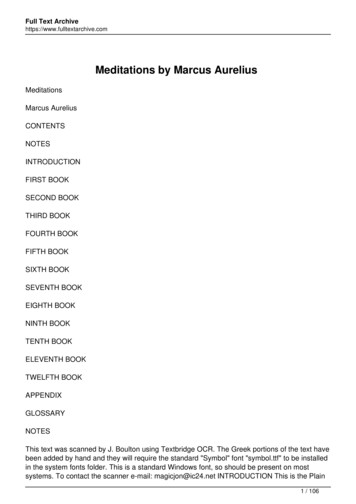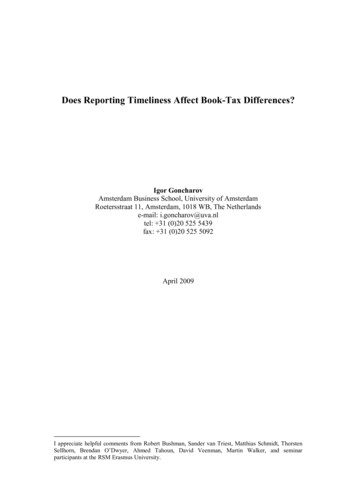
Transcription
Does Reporting Timeliness Affect Book-Tax Differences?1Igor GoncharovAmsterdam Business School, University of AmsterdamRoetersstraat 11, Amsterdam, 1018 WB, The Netherlandse-mail: i.goncharov@uva.nltel: 31 (0)20 525 5439fax: 31 (0)20 525 5092April 2009I appreciate helpful comments from Robert Bushman, Sander van Triest, Matthias Schmidt, ThorstenSellhorn, Brendan O’Dwyer, Ahmed Tahoun, David Veenman, Martin Walker, and seminarparticipants at the RSM Erasmus University.
Does Reporting Timeliness Affect Book-Tax Differences?Abstract: In Europe, a number of countries align tax accounts and parent-onlyaccounts, while allowing companies to characterize consolidated profits to capitalmarkets in a different way. Using parent-only (consolidated) accounts as a proxy fortax (book) accounts, this paper analyzes the role of reporting timeliness in inducingbook-tax income differences (BTD). I argue that users of financial statements requirethe higher timeliness of book income and show that book income records economicnews in a timelier manner. The higher timeliness of book income increases(decreases) book income relative to taxable income during periods of good (bad)news. The effect of reporting timeliness is found to be economically important as (i)higher BTD are associated with improved investment efficiency, and (ii) a delayedrecognition of economic events in tax accounts induces a positive correlation betweenaggregate BTD and future income tax revenues. These findings have implications forthe interpretation of book-tax differences in financial analysis and provide a newexplanation for the evolution of aggregate book-tax differences in the United Statesover the last years.JEL classification: G31, G32, H25, H26, M41Keywords: book-tax income differences, reporting incentives, earnings management,investments, income taxes.1
Does Reporting Timeliness Affect Book-Tax Differences?1. IntroductionPrior literature primarily argued that book-tax income differences arise whenbook and taxable incomes are opportunistically reported by management and whenaccounting rules differ for each set of accounts (Mills and Newberry, 2001; Manzonand Plesko, 2002; Desai, 2003; Lev and Nissim, 2004; Hanlon, 2005; Seidman, 2008).This study examines whether reporting timeliness (that is, incorporation of economicnews in earnings) has an incremental effect on book-tax income differences aftercontrolling for discretion in reported book and tax profits. I argue that differentincentives shape the properties of book and tax accounts, and while capital marketsdemand reporting timeliness (Burgstahler et al., 2006; Ball et al., 2008), taxauthorities are concerned about the equitable collection of revenue (Desai, 2005) andpotentially even penalize timely reporting of taxable income (Ball et al., 2000). Thiscreates a higher demand for timely reporting in book accounts—which are morerelevant for the decision making of outsiders (Hanlon et al., 2005)—and may cause asystematic variation in book-tax income differences. During good (bad) news periods,book income is expected to incorporate a larger portion of economic gains (losses),which leads to increasing (decreasing) book-tax differences.In order to provide a systematic analysis of book-tax differences, I examine asample of European countries that align tax accounts and parent-only accounts, whileallowing companies to characterize consolidated profits to capital markets in adifferent way. Although parent-only and consolidated accounts follow the sameaccounting standards (with minor exceptions), firms may exercise differentaccounting choices in these two sets of accounts. I use this institutional setting toconstruct a new proxy for book-tax differences by calculating a (signed) gap between2
income reported in consolidated and in parent-only accounts of public and privatefirms. Relying on this proxy, I confirm previous studies and show that earningsmanagement and tax planning2 widen the gap between book and tax profits. A centralresult is, however, that reporting timeliness has an incremental effect on book-taxdifferences. Due to a timelier incorporation of economic news in book accounts, thedifference between book and taxable incomes systematically varies with changes ineconomic activity.3 Furthermore, reporting timeliness seems to be economicallyimportant. I show, for example, that a delayed recognition of economic events in taxaccounts induces a positive correlation between aggregate book-tax differences andfuture income tax revenues.These findings contribute to our understanding of book-tax differences infinancial analysis. A number of studies showed that book income is more relevant toinvestors than taxable income (Hanlon et al., 2005; Hanlon et al., 2008) and that thisresult holds after controlling for opportunistic reporting in book and taxable income(Ayers et al., 2009). However, previous studies do not pinpoint “ the attributes oftaxable income (or book-tax differences), which inform the market about firmvaluation ,” and thus a research in this area “ would be a welcome addition”(Raedy, 2009, 61). I show that book-tax differences may arise when reportingdiscretion is used to enhance the usefulness of financial information reported in book2I use the term tax planning to refer to all legal and (potentially) illegal activities that lead to areduction in (the present value of) taxes. A majority of the prior studies in this area use tax sheltering,which is defined as arrangements that lead to reductions in tax payments while not exposing a companyto economic risks or losses (US Department of the Treasury, 1999; Graham and Tucker, 2006). In theempirical tests I separate between two different instruments that can be used in tax planning. The firstis earnings management for tax purposes which constitutes the use of accrual choices allowed by a taxcode to reduce the present value of taxes. The second is tax evasion—an assessment of the prevalenceof tax evasion in a country by the World Economic Forum.3Although the evidence that business conditions and the book-tax gap are linked is also present in theconcurrent research by Seidman (2008), the mechanism by which the relationship works proposed hereis new. While Seidman argues that the impact “ is largely due to the accrual vs. cash-basis nature ofbook vs. tax income” (p. 8), I consider an institutional setting where the same set of accrual accountingrules applies to both book and tax accounts. Thus, my tests suggest that reporting incentives—ratherthan accounting rules per se—should be considered as an additional driver of book-tax differences.3
accounts. Consequently, a portion of book-tax differences attributable to a moretimely incorporation of economic news in book accounts may be a source of highervalue relevance of book accounts, and explain why book income maps better into themarket’s perception of firm performance.Furthermore, the findings add to the current debate about the reasons for andpolicy implications of a growing trend in book-tax differences reported by US firms(see Hanlon and Shevlin (2005) and Hanlon et al. (2008) for an overview). A numberof studies observed that over the 1990s a gap substantially increased between reportedbook and taxable income (US Department of the Treasury, 1999; Desai, 2003; Plesko,2004; Hanlon and Shevlin, 2005; see also Figure 1). Opportunistic reporting in bookand tax profits was argued to cause this trend; and—to constrain such behavior—itwas proposed to increase book-tax conformity (Yin, 2001; Desai, 2005). I contributeto this debate by offering a new explanation for the evolution in book-tax differencesobserved in the US. Finding the book-tax gap to be affected by changes in theeconomic environment is consistent with the pattern of an increasing gap during the1990s and a reduction of the gap in 2001, when the stock markets and the economywere depressed. In this respect, I show that aggregate book-tax differences in the USare positively associated with changes in economic activity. Moreover, the trend inaggregate book-tax differences documented in prior studies disappears aftercontrolling for changes in economic activity. While reporting opportunism affectsbook-tax differences at the firm level, it does not seem to contribute to the growingtrend in aggregate book-tax differences.This evidence should be taken into account when considering policyimplications, as conforming book and tax accounts can lead to unintendedconsequences (Hanlon et al., 2008). Indeed, Hanlon et al. (2005) show that4
conforming book earnings to the tax rules will result in a 50 percent loss ofinformation content to investors. I provide some supporting evidence and show that“forcing” companies to report less timely book earnings by increasing book-taxconformity can reduce investment efficiency.Apart from its main finding, the study contributes to the literature on book-taxincome differences in the following ways. First, I provide details on the instrumentsused to manipulate reported book and tax profits that lead to a variation in book-taxdifferences. My results show that book-tax differences are systematically related tothe degree of aggressiveness in book and tax accruals and the level of tax evasion.Second, I corroborate the results of Mills and Newberry (2001) based on a proprietarydataset and document that on average public firms report higher book-tax differencesthan private firms. However, consistent with the reporting timeliness explanation, thiseffect is pronounced only during periods of good news, while during bad news yearspublic companies report lower book-tax differences. Third, I extend ourunderstanding of factors causing the book-tax differences reported by private firms(Cloyd et al., 1996; Mills and Newberry, 2001) and highlight some differences withrespect to the results obtained for public firms. I show that book-tax differences ofprivate firms are less responsive to changes in economic activity and are morepersistent. Finally, I provide further evidence on the costs of reporting higher booktax differences (Mills, 1998; Mills and Sansing, 2000) and show that in countries withhigher risks of state interference, book-tax differences tend to be lower.The discussion proceeds as follows. In section two I review the relatedliterature and develop a hypothesis. In section three the institutional setting and theresearch design are described. Results of the estimation, robustness tests, and analyses5
of economic consequences are reported in section four, and conclusions are providedin section five.2. The effect of reporting timeliness on book-tax differences2.1 Determinants of book-tax differencesMost evidence on the determinants of book-tax differences comes from theUnited States. Tax accounts in the US are reported to tax authorities and are notpublicly available, while profits from consolidated (book) accounts are classified tofinancial markets in a different way. Given that tax and book accounts follow twodistinct sets of accounting rules, tax profits do not equal book profits and the signeddifference between the two is referred to as the book-tax gap. The divergence betweenbook income and taxable income can be attributed to several factors, such as differenttreatments of depreciation, the reporting of foreign source income (Desai, 2003) ornonqualified stock options (Yin, 2001; Desai, 2003), and changes in accounting rulesthat apply to book accounts (Seidman, 2008). Furthermore, a number of articles haveargued that tax rules in general allow fewer choices than financial reporting standards(Mills and Newberry, 2001; Manzon and Plesko, 2002). Finally, recent literatureshows that reporting incentives are a powerful determinant of financial reporting(Pope and Walker, 1999; Ball et al., 2000; Daske et al., 2008).Firms have considerable discretion in reporting performance in book and taxaccounts; how this discretion is used depends on the prevailing reporting incentives(Ball et al., 2003; Burgstahler et al., 2006). If financial statements are an importantchannel for conveying information, firms can use this discretion to accurately reflectunderlying economics and report numbers that are timely and useful in decisionmaking. On the other hand, if the demand for transparent accounting information is6
low, firms are expected to use reporting discretion opportunistically. In suchsituations financial reporting is driven by other considerations, such as tax planning orearnings management, in order to achieve desirable outcomes (Burgstahler et al.,2006). According to this view, reporting incentives are expected to shape theproperties of book and tax accounts and to potentially influence reported book-taxdifferences. In this regard, Desai and Dharmapala (2006, 159) argue that, whiledivergence in accounting frameworks may contribute to book-tax differences, the gapbetween book and taxable income “ has grown in recent years beyond the levelsthat would be expected purely on the basis of differences in tax and GAAP rules.”While reporting discretion can be used in order to convey or hide trueeconomic performance, the book-tax literature has mostly concentrated onopportunism in reporting book and tax profits. Examining reporting aggressiveness inbook income indirectly, Lev and Nissim (2004) and Hanlon (2005) show that higherbook-tax differences predict a deterioration in future earnings growth rates and areassociated with a lower persistence of book income. By investigating the associationbetween deferred tax expense and a firm’s ability to meet and beat earningsthresholds, Phillips et al. (2003) find that deferred tax expense helps in predictingearnings management. Direct evidence of a relationship between reportingaggressiveness in book income and the book-tax gap is provided by Seidman (2008),who shows that the book-tax gap increases in the abnormal component of bookaccruals. Consistent with the empirical evidence, some financial analysis texts refer tohigh and/or increasing book-tax differences as “red flags” because they are potentiallyindicative of deteriorating earnings quality (Penman, 2001; Palepu et al., 2004).In addition to reporting aggressiveness in book earnings, a reliance on taxplanning in tax accounts can further widen the gap. For example, the US Department7
of the Treasury (1999) points to large and increasing book-tax differences as evidenceof a widespread use of tax sheltering. Desai (2005) reviews three high profileaccounting fraud cases—Enron, Tyco, and Xerox—and concludes that tax planningcontributed to the growing book-tax differences of these companies. Using archivaldata, Wilson (2007) demonstrates that firms found by the IRS to be involved in taxsheltering reported higher book-tax differences. Consistently, researchers have arguedthat the portion of the book-tax gap unexplained by accounting rules and earningsmanagement in book income can be attributed to tax planning (Manzon and Plesko,2002; Desai, 2003; Desai and Dharmapala, 2006; Frank et al., 2006).To summarize, prior studies model book-tax differences as a function ofaccounting rules and aggressiveness in book and taxable income. However, reportingdiscretion can be also used to enhance the usefulness of financial information. Severalstudies have argued that public firms are exposed to higher “financial reporting costs”and therefore tend to report larger book-tax differences than private firms (Cloyd etal., 1996; Mills and Sansing, 2000; Mills and Newberry, 2001). However, financialreporting costs were largely seen to be related to earnings targets set by debtcovenants, bonus plans, and market expectations, to which public companies canrespond by managing book earnings. In turn, I argue that the demand for accountinginformation originating in capital markets leads to (on average) more informative andtransparent financial statements reported by public firms (Ball and Shivakumar, 2005;Burgstahler et al., 2006; Ball and Shivakumar, 2008). As book-tax differences dependon the properties of reported book and tax profits, the book-tax gap may also capture afirm’s response to the demand for accounting information.8
2.2 Hypothesis developmentCompanies target different stakeholder groups with financial and tax reports,and contracting and taxation lead to different demands for accounting information(e.g., Beatty and Harris, 1999; Mikhail, 2001; Coppens and Peek, 2005). Capitalmarkets provide incentives for timely reporting as a higher informativeness ofearnings can resolve information asymmetries between corporate insiders andoutsiders (Burgstahler et al., 2006; Ball et al., 2008). Tax authorities, in turn, areconcerned about the equitable collection of revenue (Desai, 2005), and potentiallypenalize timely reporting (Ball et al., 2000). Indeed, high reporting timeliness impliesthat taxable income reports gains resulting from probabilistic assessments ofcompanies’ assets and liabilities. Before a transaction (for example, an asset sale)occurs, those gains are estimates and taxing them might lead to an unreasonable(liquidity) burden for a taxpayer (Nobes, 2004). Furthermore, reporting timelinessrequires substantial judgment, which is likely to increase the costs of tax audits andtax reporting. Therefore tax laws usually stress reliability over relevance, and exhibita preference for transactions over accruals (Whittington, 1995).Different demands affect the preparation of accounting reports and may leadto a variation of book income relative to taxable income. In this regard, Desai (2005,174) argues that “[c]onceptually, the many differences between book and tax profitslargely center on differing treatments associated with the timing [ ] of income.” Inthe absence of a demand for timely information in tax accounts, the desire tominimize taxes is likely to prevail and lead to a lower timeliness of taxable income.Supporting evidence for this argument is reported in recent studies that show thattaxable income exhibits lower information content than book income (Hanlon et al.,2005; Hanlon et al., 2008; Ayers et al., 2009).9
Timely incorporation of good news increases reported earnings, while timelyincorporation of bad news leads to lower net results. Higher timeliness of bookincome relative to taxable income implies a widening (narrowing) of the book-tax gapwhen firms recognize a larger portion of economic gains (losses) in book accounts.Thus, book-tax differences may grow during periods with good news (economicupturns) and decline during bad news years (economic downturns). Hanlon et al.(2005) and Hanlon and Shevlin (2005) lend some support for this discussion and pointto special items (e.g., goodwill impairment charges, restructuring charges, and writeoffs of in-process research and development) that led to lower book earnings andcaused negative book-tax differences in the year of the stock market crash in 2001.All these items can be used for a (more) timely incorporation of bad news into bookearnings. Accordingly, I hypothesize that differences in stakeholders’ reportingdemands explain part of the variation in book-tax differences:H1: Timelier incorporation in book income than in taxable income of economic gainsand losses leads to a systematic variation in book-tax differences. Book-taxdifferences increase (decrease) during periods of good (bad) news.H1 relies on the assumption that companies do not fully conform to tax ruleswhen making accounting choices in book accounts. While the evidence is quiteconvincing that companies follow different strategies in book income and taxableincome, and that book-tax differences are not solely driven by accounting rules,companies cannot costlessly disentangle book and tax accounts (Mills, 1998; Millsand Sansing, 2000). Consistent with H1, during good news periods, book-taxdifferences may increase due to a timely incorporation of gains in book income.Higher book-tax differences, in turn, increase the likelihood of tax audit adjustments10
and may be seen as “red flags” by financial analysts and other users of financialinformation. These costs are expected to be lower if managers can credibly explainthe nature of the differences to market participants, and Ayers et al. (2009) show thatinvestors are able to identify the sources of book-tax differences. Furthermore, it isdifficult to assess whether tax authorities are likely to “tax” book-tax differencesresulting from the timely incorporation of economic gains, given their probabilisticnature. Thus, the choice to record news in book accounts on a timelier basis will bebased ultimately on the trade-off between costs and benefits of this reporting strategyand will depend on the prevailing reporting incentives. The weak demand for timelyaccounting information in some countries and in private firms may reduce the powerof the tests and make it hard to find support for H1.3. Research design3.1 Institutional setting, a proxy for book-tax differences and sample selectionThis study is based on an international sample of public and private firms from1995 through 2006. As tax returns are not observable, previous studies have mostlyrelied on estimates of taxable income, which were assessed using informationreported in consolidated financial statements. To derive a proxy for taxable income,authors divided current tax expense by the top statutory tax rate (e.g., Manzon andPlesko, 2002; Lev and Nissim, 2004); sometimes a resulting amount was furtheradjusted for net operating loss carry-forwards to reduce noise in the estimate oftaxable income (Hanlon et al., 2005). Such a procedure requires detailed informationon tax related positions and poses a challenge to research relying on internationaldata. First, the databanks do not provide detailed information on tax-related positionsfor a large number of country-years and especially for private firms. Second,11
accounting rules for deferred taxes vary across countries, which induces a bias inestimating the current portion of total tax expense. To overcome this concern, I relyon an institutional setting prevalent in a majority of continental European countriesand use income from parent-only accounts as a proxy for taxable income.4In most continental European countries, parent-only accounts form the legalbasis for tax reporting, and this is often referred to as the authoritative principle. Thisregulation in income and corporate tax law takes the accounts of the legal entity totransform the reported results by applying special tax regulations.5 The outcome is astrong alignment of financial and tax reports as all accounting choices in parent-onlyreports are also binding for tax purposes (Hölscher, 1999; Choi and Meek, 2005;Delvaille et al., 2005; Sellhorn and Gornik-Tomaszewski, 2006). In some countriesthis connection is strengthened, as the inverse of the principle also applies, implyingthat particular accounting choices that are exerted only for taxation are also bindingfor parent-only reports (Jacobs, 1995; Hölscher, 1999; Jacobs, 2007).Consolidated accounts are not affected by the authoritative principle (Sellhornand Gornik-Tomaszewski, 2006; Volmer et al., 2007). There is no legally binding rulethat requires the incorporation of tax considerations into consolidated accounts. Infact, there are laws that explicitly prohibit the use of tax treatments in consolidatedaccounts (for example, German Transparency and Disclosure Act of 2002). This leadsto the requirement to publish two sets of accounts following the same accountingstandards: parent-only accounts that are aligned with tax reports and consolidated4To the best of my knowledge, this is the first attempt to construct a firm-specific measure of book-taxdifferences in an international setting.5These adjustments include, for example, loss carry-backs and carry-forwards. Therefore, parent-onlyincome does not equal taxable income. However, because many tax choices that companies may applyto reduce (the present value of) taxes (e.g., tax planning via profit transfer agreements, discretion inexercising accounting policy choices) are applied in parent-only accounts, parent-only income can beseen as a proxy for taxable income. In the following, I refer to consolidated income as book income,while parent-only earnings are referred to as taxable income.12
accounts that are allowed to characterize profits to capital markets in a different way.6Previous studies documented that the properties of earnings reported in parent-onlyand consolidated accounts differ, pointing to the fact that companies prepare them fordifferent purposes (Harris et al., 1994; Niskanen et al., 1998). Goncharov et al. (2009)further show that while consolidated accounts have a number of functions invaluation, contracting, and dividend policy, tax considerations primarily determine thepreparation of parent-only accounts.Using this institutional set-up, I construct a proxy for book-tax differences bycalculating the gap between consolidated income before taxes and parent-only incomebefore taxes. This measure can potentially overcome the limitations of theconventional measures of book-tax differences (e.g., Manzon and Plesko, 2002; Levand Nissim, 2004). First, it does not rely on the assumption that the top statutory taxrate used in grossing up of tax expense is equal to the average tax rate. Second,accounting rules used for reporting consolidated and parent-only accounts are largelythe same: consolidated and parent-only accounts use the provisions of the same(national) accounting standards. Since 2005, listed companies have had to apply IFRSfor consolidated accounts, but consolidated and parent-only accounts of privatecompanies still follow the previous accounting rules. Hence, no adjustments foraccounting differences—such as defining the basis of consolidation and accountingfor nonqualified stock option compensation (Manzon and Plesko, 2002)—isnecessary. Having a complete set of tax accounts (here: parent-only accounts) allows6Apart from different accounting choices, the differences between parent-only and consolidatedaccounts are largely due to the presentation format of investments in subsidiaries. In parent-onlyaccounts, these investments are recorded as financial investments, while all distributions fromsubsidiaries to a parent company are recognized as financial income. Consolidated accounts portray theeconomic entity as a whole and thus record all assets and liabilities (all incomes and expenses) in onesingle balance sheet (income statement).13
the estimation of reporting aggressiveness in taxable income. Thus, the paper willhave a unique opportunity to shed light on different instruments of tax planning.Subsequent results show that the proxy based on the difference betweenconsolidated income and parent-only income is systematically related to factors thatwere previously found to affect the book-tax gap. I show that the proxy is positivelyassociated with aggressiveness in book earnings and the degree of tax planning. Thisanalysis validates the use of the difference between consolidated and parent-onlyincome as a proxy for the book-tax gap.To construct a proxy for book-tax differences, I concentrate on a sample ofEuropean countries that have high levels of alignment between parent-only and taxaccounts. The starting point of my inquiry is the study by Jacobs (1995) that reviewsthe national tax laws in the 15 countries of the European Union and shows that 11countries rely on the authoritative principle in the tax law. This list was further crossreferenced for consistency with other sources (Hung, 2001; Comprix et al., 2003;Burgstahler et al., 2006; Jacobs, 2007) resulting in no country deletions. The data onparent-only and consolidated accounts were obtained from Bureau van Dijk’sAmadeus Databank (previously used in Burgstahler et al. (2006) and Peek et al.(2008)). Because data from parent-only accounts are not available for Greece andLuxemburg, the final sample was reduced from 11 to 9 countries: Austria, Belgium,Finland, France, Germany, Italy, Portugal, Spain, and Sweden.As calculation of the book-tax gap requires information on parent-only andconsolidated income, I delete firm-year observations with missing data from parentonly or consolidated accounts and missing financial information. Firm-yearobservations of financial firms are also deleted. Finally, for the multivariate analysis Idrop observations in the 1st and the 99th percentiles of the (pooled) book-tax14
differences distribution. This selection procedure leads to a sample of 24,708 firmyear observations (referring to 5,878 unique firms) with 4,663 (20,045) firm-yearobservations being in public (private) subsamples.- Insert Figure 1 about here A time-series analysis of aggregate book-tax differences in the samplecountries is shown in Figure 1. Additionally, Figure 1 graphs the book-tax differencesfor the US market based on aggregate book and taxable income for a large sample ofUS companies for the years 1985–2003 (Hanlon and Shevlin, 2005). To construct thisfigure I use data from the last row of Table 1 in Hanlon and Shevlin (2005) thatreports the ratio of the aggregate book income to the aggregate taxable income. Icalculate a similar ratio for the sample of 9 European countries (EU9) using parentonly income as a proxy for taxable income. The book-tax gaps in US and Europeanmarkets display some similarities, which may be seen as an indication of commonfactor(s) driving book-tax differences. The book-tax gap increased in the US duringthe 1990s (p 0.0257) and also grew in the European market during the period 1995–2000 (p 0.046). In Europe this period is usually attributed to economic expansion(Beuselinck et al., 2007). The growing gap declined rapidly in 2001, the year theInternet bubble collapsed and there was a rapid contraction of GDP growth in Europe.This evidence is consistent with the view that book-tax differences may be aff
market's perception of firm performance. Furthermore, the findings add to the current debate about the reasons for and policy implications of a growing trend in book-tax differences reported by US firms (see Hanlon and Shevlin (2005) and Hanlon et al. (2008) for an overview). A number

